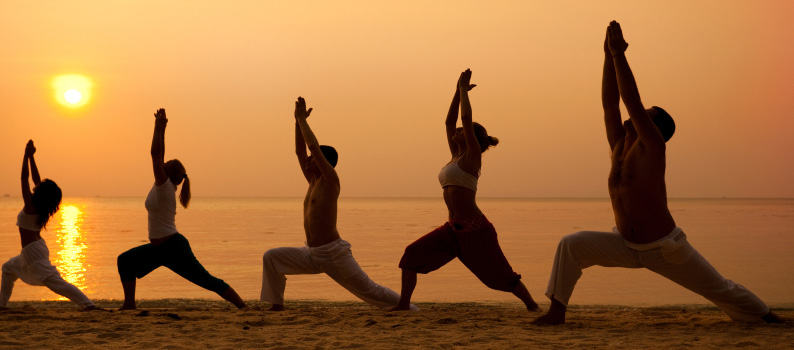History of Yoga

Yoga is a Hindu spiritual and ascetic discipline, a part of which, including breath control, simple meditation, and the adoption of specific bodily postures, is widely practiced for health and relaxation. In Vedic Sanskrit, yoga means "to add", "to join", "to unite", or "to attach" in its most common literal sense. It also could take on meanings such as connection, contact or union. There is a broad variety of schools, practices and goals in Hinduism, Buddhism, particularly Vajrayana Buddhism and Jainism. The best-known are Hatha yoga and Rāja yoga.
Origin
The origins of yoga have been speculated to date back to pre-Vedic Indian traditions, but most likely developed around the sixth and fifth centuries BCE, in ancient India's ascetic and śramaṇa movements.
Although Yoga is said to be as old as civilization, there is no physical evidence to support this claim. Earliest archaeological evidence of Yoga's existence could be found in stone seals which depict figures of Yoga Poses.
- Vedic Period,
- Pre-Classical Period,
- Classical Period, and
- Post-Classical Period.
Vedic Period
The existence of the Vedas marks this period. The Vedas is the sacred scripture of Brahmanism that is the basis of modern-day Hinduism. It is a collection of hymns which praise a divine power. The Vedas contains the oldest known Yogic teachings and as such, teachings found in the Vedas are called Vedic Yoga. This is characterized by rituals and ceremonies that strive to surpass the limitations of the mind.
During this time, the Vedic people relied on rishis or dedicated Vedic Yogis to teach them how to live in divine harmony. Rishis were also gifted with the ability to see the ultimate reality through their intensive spiritual practice. It was also during this time that Yogis living in seclusion (in forests) were recorded.
Pre-Classical Yoga
The creation of the Upanishads marks the Pre-Classical Yoga. The Upanishads explain the teachings of the Vedas.
Yoga shares some characteristics not only with Hinduism but also with Buddhism that we can trace in its history. During the sixth century B.C., Buddha started teaching Buddhism, which stresses the importance of Meditationand the practice of physical postures. Siddhartha Gautama, the first Buddhist to study Yoga, achieved enlightenment at the age of 35.
Classical Period
The Classical Period is marked by another creation - the Yoga Sutra. Written by Patanjali around the second century, it was an attempt to define and standardize Classical Yoga. It is composed of 195 aphorisms or sutras (from the Sanskrit word which means thread) that expound upon the Raja Yoga and its underlying principle, Patanjali's Eightfold path of Yoga (also called Eight Limbs of Classical Yoga). These are:
2. Niyama, which is personal observance of purity, tolerance, and study;
3. Asanas or physical exercises;
4. Pranayama, which means breath control or regulation;
5. Pratyahara or sense withdrawal in preparation for Meditation;
6. Dharana, which is about concentration;
7. Dhyana, which means meditation; and
8. Samadhi, which means concentration.
Patanjali believed that each individual is a composite of matter (prakriti) and spirit (purusha). He further believed that the two must be separated in order to cleanse the spirit - a stark contrast to Vedic and Pre-Classical Yoga that signify the union of body and spirit.
Patanjali's concept was dominant for some centuries that some Yogis focused exclusively on Meditation and neglected their Asanas. It was only later that the belief of the body as a temple was rekindled and attention to the importance of the Asana was revived. This time, Yogis attempted to useYoga techniques to change the body and make it immortal.
Post-Classical Yoga
At this point, we see a proliferation of literature as well as the practice of Yoga. Post-classical Yoga differs from the first three since its focus is more on the present. It no longer strives to liberate a person from reality but rather teaches one to accept it and live at the moment.
Yoga was introduced in the West during the early 19th century. It was first studied as part of Eastern Philosophy and began as a movement for health and vegetarianism around the 1930's. By the 1960's, there was an influx of Indian teachers who expounded on Yoga. One of them was Maharishi Mahesh, the Yogi who popularized Transcendental Meditation. Another one is a prominent Yoga Guru Swami Sivananda.
- Shavasana or proper relaxation;
- Asanas or proper exercise;
- Pranayama or proper breathing;
- Proper diet; and
- Dhyana or positive thinking and Meditation
Thus on a concluding note, till today, yoga continues to proliferate and spread its teachings, crossing the boundaries of culture and language.
- Karma Yoga
- Jnana Yoga
- Bhakti Yoga
- Kriya Yoga
- Asanas / Postures
- ARDHACAKRASANA
- BHUJANGASANA
- CHACKRASANA
- DHANURASANA
- View More
- Different forms of Yoga
- Hatha Yoga
- Kundalini Yoga
- Bhakti Yoga
- Karma Yoga
- View More
- Pranayama
- Suryabhedan
- Ujjayi
- Sheetali
- Sheetkari
- View More
- UN Declaration of Yoga Day
- Objectives of World Yoga Day
- Controversy on Yoga day
- Logo of Internation Yoga Day
- Fundamentals of Yoga
- Hand Mudra
- Yoga Day Messages
- Yoga Day SMS
- Yoga Day What's App Messages
- Yoga Day Essay
- Yoga Day Speech
- When is Yoga Day
- Yoga Day Quotes
- Yoga Day Poems
- Benefits of Yoga
- Slogans on Yoga
- Yoga Day Clipart
- Yoga Day Images
- Articles
- A Way Celebrating Your Health
- 10 Extraordinary benefits of Yoga
